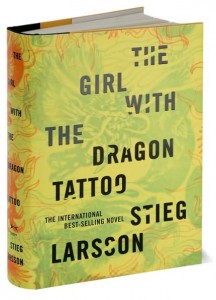 Originally titled Men Who Hate Women in Swedish, journalist Stieg Larsson’s The Girl with the Dragon Tattoo has sold over 4 million copies in Scandinavia. It is the first book in his Millennium Trilogy. At his sudden death in 2004 of a heart attack, he left behind this and two other unpublished novels that completed the trilogy; sadly, he was never able to witness their publication or success. Among his many accomplishments as an activist and journalist, Larsson founded the Swedish magazine Expo, which exposed extremist right-wing and racist groups. He worked on his crime sagas at night. The Girl with the Dragon Tattoo became a hit throughout Europe upon publication in January 2008; this fall, it finally reached the United States (translated from the Swedish by Reg Keeland) as a bestseller, too.
Originally titled Men Who Hate Women in Swedish, journalist Stieg Larsson’s The Girl with the Dragon Tattoo has sold over 4 million copies in Scandinavia. It is the first book in his Millennium Trilogy. At his sudden death in 2004 of a heart attack, he left behind this and two other unpublished novels that completed the trilogy; sadly, he was never able to witness their publication or success. Among his many accomplishments as an activist and journalist, Larsson founded the Swedish magazine Expo, which exposed extremist right-wing and racist groups. He worked on his crime sagas at night. The Girl with the Dragon Tattoo became a hit throughout Europe upon publication in January 2008; this fall, it finally reached the United States (translated from the Swedish by Reg Keeland) as a bestseller, too.
The novel focuses on a middle-aged journalist named Mikael Blomkvist, publisher of a well-known Stockholm-based magazine called Millennium. After losing a libel case brought by a Swedish industrialist gangster named Wennerstrom, Blomkvist is hired by Henik Vanger, the CEO of the wealthy Vanger Corporation, to write a memoir of the family’s history. Henrik’s real reason for hiring the journalist is to solve a cold case – the disappearance of Vanger’s niece Harriet when she was sixteen in the small town of Hedestad. The town is largely populated by the scions of the Vanger family, and the forty-year-old cold case points to one of them as the suspect. Thrown into the mix is the Girl with the Dragon Tattoo, Lisbeth Salander—a ruthless, tattooed, punk hacker who has been victimized by authorities her entire life and was paid to dig up everything about Blomkvist after his libel trial brought him into media attention. Blomkvist becomes impressed with her hacking abilities, and the two set out to find the answers to Harriet’s disappearance, forging a love connection while turning into the hunted during their quest for the truth.
Barnes and Noble Studio features an interview with Sonny Mehta (scroll down to watch it), who suggests that “Stieg Larsson was fascinated with the idea of who Pippi Longstocking would become.” He found that answer in the character of Lisbeth Salander, creating a modern young woman who is tough as well as brilliant. Larsson draws parallels between her and the deceased Harriet—particularly their continual abuse by men, a theme that breaks up the sections of the novel with statistics like “Eighteen percent of the women in Sweden have at one time been threatened by a man,” or “Forty-six percent of the women in Sweden have at one time been subjected to violence by a man.” Lisbeth has already experienced multiple abuses in her young life, from sexual assault to time spent in a psychiatric clinic. She takes revenge on those she deems bad, which draws her to Harriet’s case. The novel is also populated with the Vanger clan, all suspects, but all flat characters as well. There are many of them, and with the exception of the two leads, they often become muddled.
The mystery behind the young girl’s disappearance is very well orchestrated, with enough red herrings and twists and turns to keep the pages flying by. Themes of corrupt corporations, lingering Nazism, and the separation between love and lust swirl around these characters as they try to make sense of a crime that even the authorities have lost interest in. Peppered throughout the novel are mentions of other crime writers – Agatha Christie, Val McDermid, Sara Paretsky – who Blomkvist reads vigorously in his pursuit for solutions. In these sections, Larsson tips his hat to the authors whose work he loved and studied. The world of Stockholm and the freezing tundra of Hedestad are expertly sketched, the icy surroundings reflecting both the Vanger family’s demeanor and Blomkvist’s and Salander’s own shortcomings.
A major problem in the novel, however, is that Harriet’s case gets solved far too early, so the last 100 pages are left to sort out Blomkvist’s takedown of the gangster Wennerstrom and his attempt to bring the magazine Millennium back to its former glory after his name is dragged through the mud. Its final section aside, The Girl with The Dragon Tattoo is perfect for a long flight, and you’re likely find it in most airport bookstores. Due to its success, U.S. readers can look forward to the subsequent novels of the Millennium Trilogy in stores soon.
Read an excerpt from The Girl with the Dragon Tattoo here.
Watch Barnes and Noble’s interview with Knopf’s Sonny Mehta, who discusses The Girl with the Dragon Tattoo:





